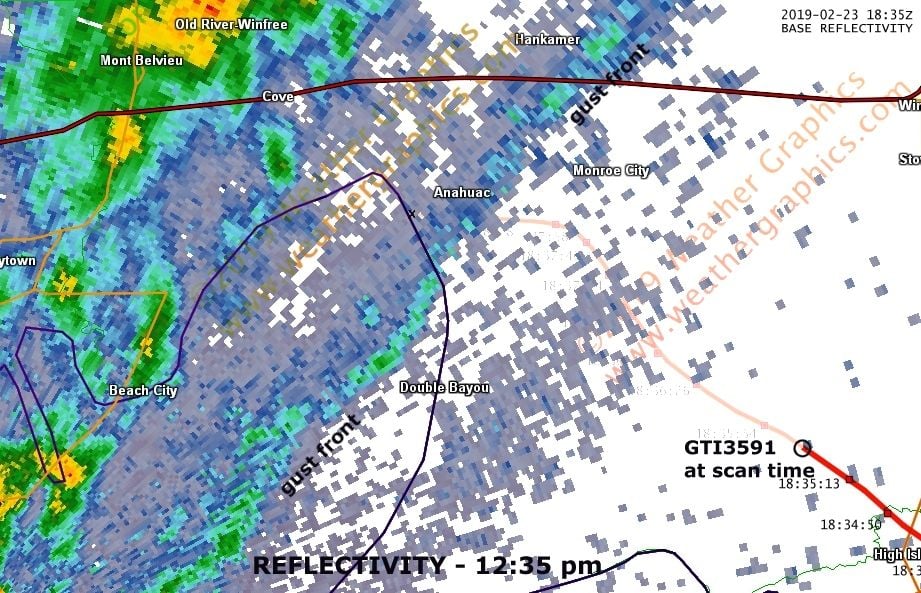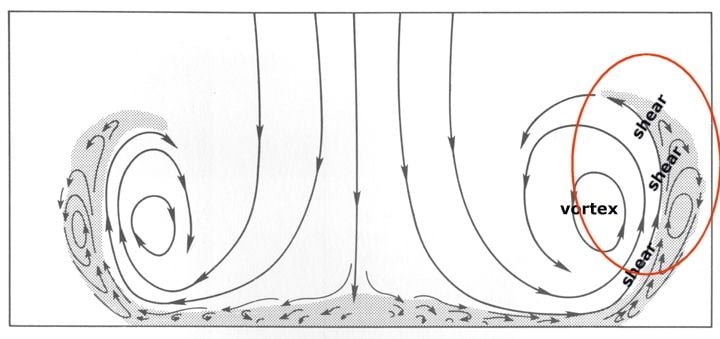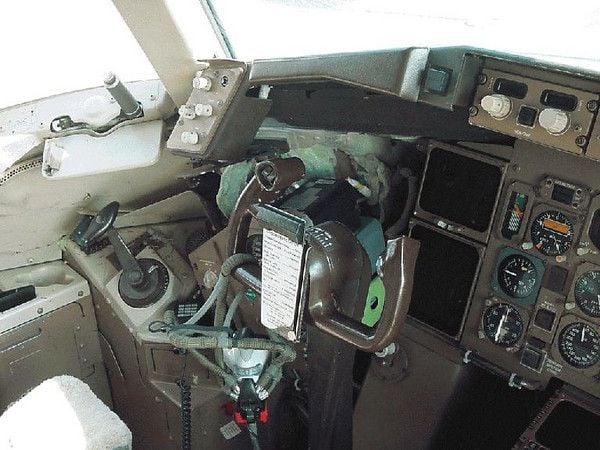Atlas Air 767 down/Texas
Join Date: Mar 2014
Location: WA STATE
Age: 78
Posts: 0
Likes: 0
Received 0 Likes
on
0 Posts
The windscreen and surrounding structure is common between the 757, 767, and 777, and I'm not aware of any windscreen penetrations on any of those types.
However there is still a risk with large birds - during the development of the 757-300 and 767-400ER, it was determined there was a vulnerability with the forward bulkhead - a large enough bird could penetrate into the flight deck. I don't know if the requirements changed after the initial 757/767 cert, or it was due to better analysis tools, but the bulkhead had to be beefed up in some areas. I'm reasonably sure it was never retrofit.
90,000 hours is not that old for a 767 - even before I retired I was aware of several passenger 767s that had more than 100,000 hours and were still going strong.
However there is still a risk with large birds - during the development of the 757-300 and 767-400ER, it was determined there was a vulnerability with the forward bulkhead - a large enough bird could penetrate into the flight deck. I don't know if the requirements changed after the initial 757/767 cert, or it was due to better analysis tools, but the bulkhead had to be beefed up in some areas. I'm reasonably sure it was never retrofit.
90,000 hours is not that old for a 767 - even before I retired I was aware of several passenger 767s that had more than 100,000 hours and were still going strong.
The result was that the ' skull cap' above the windscreen and the window framework had to be redesigned mostly with titanium. The skull cap cuz some important switches and valves were located there and damage or loss could cause major flight control issues- but still had to be within reach of pilot and copilot..
While the first one or two flyable 767.s built may not have had the rework, I am sure all the rest had that redesign.
Last edited by CONSO; 24th Feb 2019 at 17:46. Reason: fat fingers
Birds have penetrated the forward bulkhead in front of the cockpit of a 767-300 at least once before. Medium sized birds blasted through it on one flight, fortunately missing the Captain but sending blood, guts and feathers against the aft left wall of the cockpit.
Join Date: May 2015
Location: Orbit
Posts: 48
Likes: 0
Received 0 Likes
on
0 Posts
Airframetime should't be issue, our 76-3 were the first to exceed 100k worldwide according to our airline and recieved an extension to 150k with an adapted maintenance program. Planes still flew fine

Join Date: Mar 2014
Location: WA STATE
Age: 78
Posts: 0
Likes: 0
Received 0 Likes
on
0 Posts
tdracer said ..
One subtle reason for the very long fatigue life of the 767 and related was the extensive use of two Boeing devlopd processes. One being a technique called ' coldworking " details of which can be found in manuals, info provided by Fatigue Technology ( http://www.fatiguetech.com/ ) developed in the late 60's by Lou Champoux ( next to my desk ) at the time.. In simple terms, bypushing/pulling a mandrel thru a sleeve inserted in the hole - or a special mandrel without a sleeve, the hole stretches leaving the nearby surrounding material in tension, which then results in major fatigue improvement. This techniques was used on main spars, lower wing panels, parts of wing box and some parts of fuselage, etc.
The second process also ' first ' used on major spar assembly was/is called ElectroMagneticRiveting - which uses magnetic drivers to drive and expand a rivet in ONE blow, which also has a major effect on fatigue life. Although the process had been used on smaller parts/assemblies since early 747 days, the use on major spar assembly was a first on 767. The machine was known as ASAT automatic assembly tool. That also was the founding of a company used around the world as improved and further developed by a company called Electro Impact - whos major facility is next to Boeing Everett. They have branched out since then with major wing composite layup for 777X. And no - I do not and have not worked for ElectroImpact or Fatigue Technolocy but have had many personal contacts/background with those involved in both companies over the years.
90,000 hours is not that old for a 767 - even before I retired I was aware of several passenger 767s that had more than 100,000 hours and were still going strong.
The second process also ' first ' used on major spar assembly was/is called ElectroMagneticRiveting - which uses magnetic drivers to drive and expand a rivet in ONE blow, which also has a major effect on fatigue life. Although the process had been used on smaller parts/assemblies since early 747 days, the use on major spar assembly was a first on 767. The machine was known as ASAT automatic assembly tool. That also was the founding of a company used around the world as improved and further developed by a company called Electro Impact - whos major facility is next to Boeing Everett. They have branched out since then with major wing composite layup for 777X. And no - I do not and have not worked for ElectroImpact or Fatigue Technolocy but have had many personal contacts/background with those involved in both companies over the years.
Join Date: Mar 2014
Location: WA STATE
Age: 78
Posts: 0
Likes: 0
Received 0 Likes
on
0 Posts
My point was to SIMPLY explain the test used to detrmine design parameters, I'm sure the FAA an various wildlife protection agencies can explain why chickens and turkeys instead o geese, etc.
see also
Join Date: Sep 2007
Location: New York
Posts: 225
Likes: 0
Received 0 Likes
on
0 Posts
Part 121 fuel requirements
Refers to 30 minutes final reserve holding at 1500 above alternate (or destination if alternate not required). This must be intact on landing.
May be slightly different in FAA land (I have only flown reciprocating engine aircraft under FAA rules) but those are the ICAO requirements for jets.
Thoughts with the families and friends of the victims at this awful time.
The aircraft must be dispatched with a planned amount of fuel on landing. If you burn it all without declaring a problem to ATC and your dispatcher that's a violation; but it's a planning requirement only.
Its Atlas. As well as the Amazon 767 s they operate the worlds largest 747 fleet. 400s & -8's. They know what they're doing.
Instead of all these what-if combinations I would prefer to parse the discussions down to the supporting facts at this time with no more than one leap of speculation beyond what is known.
Question. Do we know the length and spread of the debris trail ?
does that give us a hint of the attitude of the plane during break-up?
Question. Do we know the length and spread of the debris trail ?
does that give us a hint of the attitude of the plane during break-up?
Instead of speculating, you might want to watch the ntsb press conference at 2200Z.
https://mobile.twitter.com/NTSB_Newsroom
https://mobile.twitter.com/NTSB_Newsroom
Join Date: Jan 2015
Location: Banksville
Posts: 70
Likes: 0
Received 0 Likes
on
0 Posts
Join Date: Dec 2013
Location: OKC
Posts: 11
Likes: 0
Received 0 Likes
on
0 Posts
Tim Vasquez, meteorologist in Texas here... weather data analysis is what I do for a living, and some of you may remember me from the Air France 447 study about 10 years ago.
Regarding the 767 crash in Houston, a lot of images seem to be floating around that use default radar mosaics. These are problematic as they're focused on higher intensity levels, they are not very granular, they often carry an ambiguous scan time, and they're often built from composite products which are the result of multiple scans rather than a single scan. This makes it very difficult to use such data except to define the basic environment. In fact, I initially didn't think much of weather being a factor based on the preliminary images I saw. However I went ahead and accessed the raw WSR-88D base data files, which are for a single level and accurate to within about 1 minute, and I found some interesting stuff.
First of all, one caveat with these images: the ones I've posted here are built from 0.5-deg scans, which were underneath the 767 at a beam center altitude of about 2000-2500 ft and a beam width of about 2000 ft. I used these because there are usually a lack of scatterers at the higher tilts, and most of the convective circulations we see above 5000+ ft are initially generated near the surface. So there are indeed some assumptions about what is going on up at 5000 ft, where the problem presumably started. Time stamps are based on the FlightAware track log, which comes straight from the ASDI feed. My assumption is these times are accurate. Sorry for the watermarks, I got burned back in 2009 by the media reprinting my diagrams commercially without permission.
A couple of conclusions:
* A textbook gust front is clearly shown within 3 nm of the crash site. This correlation is definite and is striking.
* There were no thunderstorms within 5 nm of the crash site. There may have virga or weak showers though.
* It appears some sort of gust surge developed over northern Trinity Bay, lasting about 10 minutes, originating from the storms further west near Baytown, and it reinforced the gust front. This developed ground-relative motion of 50-60 kt along a band 6 nm long oriented NE-SW.
* Velocity product showed a transitory divergent couplet with 65 kt of shear within a 1 nm volume, slightly below and left of the track. This could be a piece of the northern edge of the gust surge. This is probably associated with turbulent motion, as the result of shear & friction along the frontal boundary.
* Velocity at higher levels (4000+ ft) and along the forward edge of the gust front are typically difficult to determine in these situations because a lack of scatterers.
* I don't think a gust front like this is anything that looks particularly dangerous. That said, it's impossible to directly measure turbulence, and in between the turbulence and cloud scales there are often strong circulations that can go undetected. Typically when we see small-scale patterns on radar imagery with strong gradients and circulation, we consider the possibility that strong motions can extrapolate down to the smaller scales. It's certainly possible that this gust surge rolled up into a vortex like I've shown in the cross-section below.. this can certainly be a hazardous area to fly in.
In short I'm skeptical weather caused a direct effect, but I do see enormous potential for a sudden, rough ride here, and that could have been the first event in a chain that led to something like a CG shift or loss of a control surface (from fatigue, improper maintenance, design issue, something like the 737 in Colorado Springs, etc).
It would be interesting to see what the TDWR radars showed, unfortunately as I have to attend to my other work I probably won't have time to look at this.
Anyway this is just an armchair analysis and I'm sure the investigators have more information at this point than we do, but it's nice to have quantitative data to work from.





Conceptual vertical cross section of air flow along a gust front ahead of a microburst.
Regarding the 767 crash in Houston, a lot of images seem to be floating around that use default radar mosaics. These are problematic as they're focused on higher intensity levels, they are not very granular, they often carry an ambiguous scan time, and they're often built from composite products which are the result of multiple scans rather than a single scan. This makes it very difficult to use such data except to define the basic environment. In fact, I initially didn't think much of weather being a factor based on the preliminary images I saw. However I went ahead and accessed the raw WSR-88D base data files, which are for a single level and accurate to within about 1 minute, and I found some interesting stuff.
First of all, one caveat with these images: the ones I've posted here are built from 0.5-deg scans, which were underneath the 767 at a beam center altitude of about 2000-2500 ft and a beam width of about 2000 ft. I used these because there are usually a lack of scatterers at the higher tilts, and most of the convective circulations we see above 5000+ ft are initially generated near the surface. So there are indeed some assumptions about what is going on up at 5000 ft, where the problem presumably started. Time stamps are based on the FlightAware track log, which comes straight from the ASDI feed. My assumption is these times are accurate. Sorry for the watermarks, I got burned back in 2009 by the media reprinting my diagrams commercially without permission.
A couple of conclusions:
* A textbook gust front is clearly shown within 3 nm of the crash site. This correlation is definite and is striking.
* There were no thunderstorms within 5 nm of the crash site. There may have virga or weak showers though.
* It appears some sort of gust surge developed over northern Trinity Bay, lasting about 10 minutes, originating from the storms further west near Baytown, and it reinforced the gust front. This developed ground-relative motion of 50-60 kt along a band 6 nm long oriented NE-SW.
* Velocity product showed a transitory divergent couplet with 65 kt of shear within a 1 nm volume, slightly below and left of the track. This could be a piece of the northern edge of the gust surge. This is probably associated with turbulent motion, as the result of shear & friction along the frontal boundary.
* Velocity at higher levels (4000+ ft) and along the forward edge of the gust front are typically difficult to determine in these situations because a lack of scatterers.
* I don't think a gust front like this is anything that looks particularly dangerous. That said, it's impossible to directly measure turbulence, and in between the turbulence and cloud scales there are often strong circulations that can go undetected. Typically when we see small-scale patterns on radar imagery with strong gradients and circulation, we consider the possibility that strong motions can extrapolate down to the smaller scales. It's certainly possible that this gust surge rolled up into a vortex like I've shown in the cross-section below.. this can certainly be a hazardous area to fly in.
In short I'm skeptical weather caused a direct effect, but I do see enormous potential for a sudden, rough ride here, and that could have been the first event in a chain that led to something like a CG shift or loss of a control surface (from fatigue, improper maintenance, design issue, something like the 737 in Colorado Springs, etc).
It would be interesting to see what the TDWR radars showed, unfortunately as I have to attend to my other work I probably won't have time to look at this.
Anyway this is just an armchair analysis and I'm sure the investigators have more information at this point than we do, but it's nice to have quantitative data to work from.





Conceptual vertical cross section of air flow along a gust front ahead of a microburst.
Last edited by tvasquez; 24th Feb 2019 at 20:42. Reason: clarification
Salute. Tim!
Good stuff, and it might be relevant if shear or gust had an effect on cargo shift, as some are already discussing.
BTW, I am discounting bird strikes, as we should have heard radio calls like we did with Sully. Something really bad happened, and it happened quickly and crew was BZ trying to save their lives and not talking.
Gums sends...
Good stuff, and it might be relevant if shear or gust had an effect on cargo shift, as some are already discussing.
BTW, I am discounting bird strikes, as we should have heard radio calls like we did with Sully. Something really bad happened, and it happened quickly and crew was BZ trying to save their lives and not talking.
Gums sends...
Join Date: Nov 2007
Location: Texas, like a whole other country
Posts: 444
Likes: 0
Received 2 Likes
on
1 Post
NTSB presser just finished. There wasn't much new that hasn't already been covered here. One item of mention is that there is a video of the plane going down which was taken from a camera at the Chambers County Jail, a bit more than a mile away.It shows the plane in a nose down attitude for about five seconds. The video has been sent to the NTSB labs. It won't be released to the public until it's made part of the official NTSB docket, probably some months from now. The Chambers County Sheriff did say two bodies have been recovered; they have not yet been identified.
Last edited by Carbon Bootprint; 24th Feb 2019 at 21:44.





